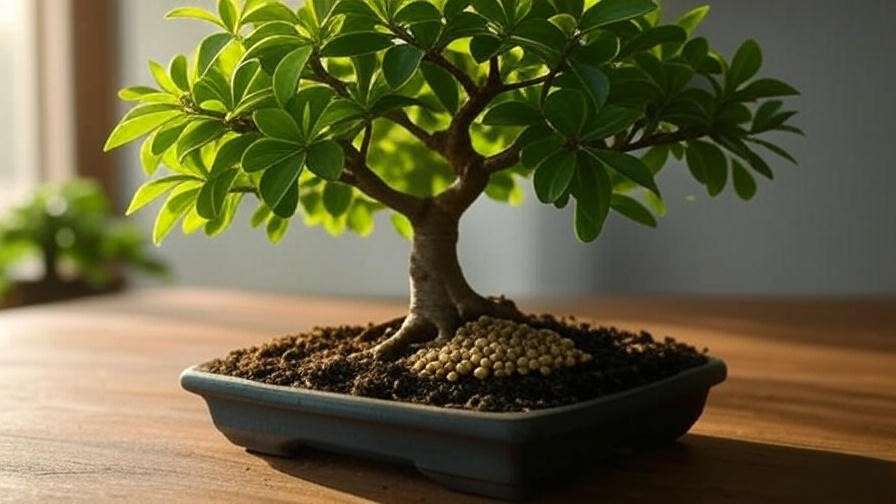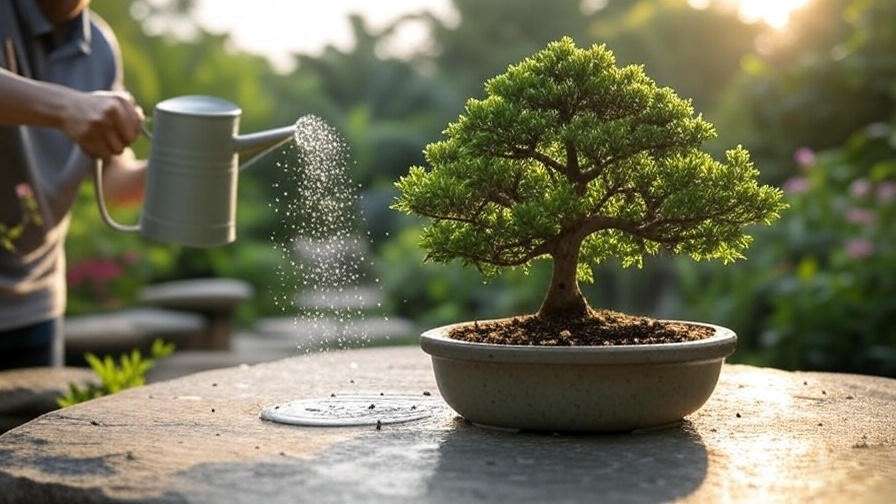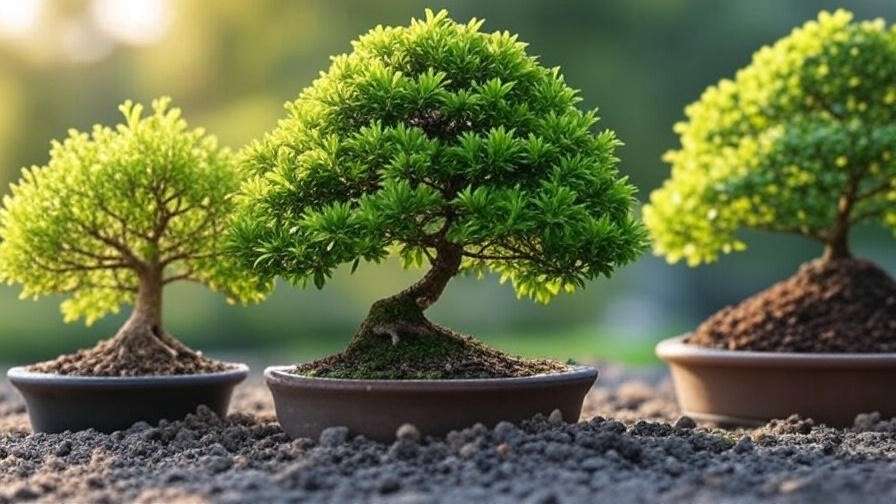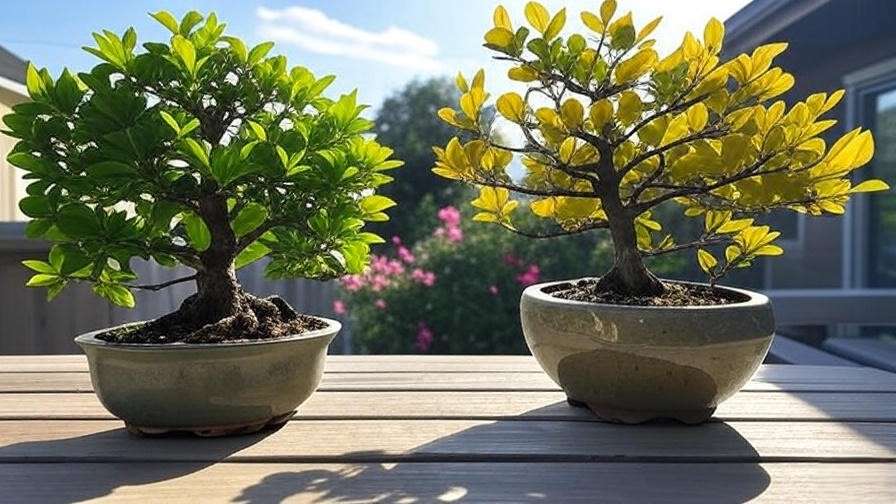Picture this: your cherished bonsai tree, a miniature masterpiece, starts to lose its luster. Leaves yellow, growth stalls, and that vibrant spark fades. The culprit? Often, it’s improper fertilisation. Choosing the right bonsai tree fertiliser is the key to unlocking your tree’s full potential, ensuring it thrives for years. As a bonsai enthusiast with over a decade of experience and insights from horticultural experts, I’ve seen firsthand how the right nutrients transform struggling trees into stunning displays. This comprehensive guide will walk you through everything you need to know about bonsai tree fertilisers—from types and application techniques to top product recommendations—empowering you to nurture your miniature trees like a pro. Ready to grow? Let’s dive in! 🌿
1. Why Bonsai Trees Need Specialised Fertiliser 🌿
Bonsai trees aren’t just small plants; they’re living art forms with unique needs. Unlike garden trees, bonsai live in confined pots with limited soil, restricting their access to nutrients. This makes specialised bonsai tree fertiliser essential for their health, growth, and beauty.
1.1 The Unique Nutritional Needs of Bonsai
Bonsai trees have restricted root systems, meaning they can’t forage for nutrients like their wild counterparts. The small volume of soil in their pots depletes quickly, requiring regular, balanced fertilisation. Without it, your bonsai may suffer from stunted growth, weak branches, or dull foliage. Over-fertilisation, however, can burn roots or cause excessive leaf growth, ruining the tree’s delicate balance. The goal is to mimic nature’s nutrient supply in a controlled way, tailored to your bonsai’s species and environment.
1.2 How Fertilisers Support Bonsai Health
Fertilisers provide essential macronutrients—nitrogen (N), phosphorus (P), and potassium (K)—along with micronutrients like iron, magnesium, and calcium. Nitrogen promotes lush foliage, phosphorus strengthens roots and encourages flowering, and potassium boosts overall vigor. Micronutrients ensure vibrant colors and prevent deficiencies, like yellowing leaves due to low iron.
Case Study: Take Sarah, a bonsai hobbyist from California. Her Japanese maple bonsai was dropping leaves despite regular watering. After consulting a local nursery, she switched to a balanced bonsai tree fertiliser with a 10-10-10 NPK ratio. Within weeks, her tree’s foliage regained its rich red hue, and new growth appeared. Proper fertilisation made all the difference!
Expert Tip: “Fertilising a bonsai is like feeding a child—too little starves them, too much overwhelms them,” says bonsai master Hiroshi Tanaka. A tailored approach is key.
2. Types of Bonsai Tree Fertilisers: Which One Is Right for You? 🌸
With so many fertiliser options, choosing the best one can feel overwhelming. Let’s break down the main types—organic, synthetic, and slow-release—to help you find the perfect fit for your bonsai.

2.1 Organic Fertilisers
Organic fertilisers, like fish emulsion, bone meal, or compost tea, are derived from natural sources. They release nutrients slowly, enriching the soil microbiome and promoting long-term health.
- Pros: Eco-friendly, improves soil structure, safe for sensitive bonsai species.
- Cons: Slower results, potential odor, less precise nutrient ratios.
- Best for: Eco-conscious growers or species like pines and junipers that thrive with gradual feeding.
Example: Fish emulsion, with an NPK of around 5-1-1, is a favorite for organic bonsai care, providing gentle nutrition without overwhelming delicate roots.
2.2 Synthetic Fertilisers
Synthetic fertilisers, such as liquid concentrates or granular formulas, are chemically formulated for precise nutrient delivery. They’re fast-acting and widely available.
- Pros: Quick results, exact NPK ratios, easy to apply.
- Cons: Risk of over-fertilisation, less sustainable, may build up salts in soil.
- Best for: Beginners or those needing rapid nutrient boosts for struggling trees.
Example: A 20-20-20 liquid fertiliser diluted to half-strength is ideal for quick recovery in nutrient-deficient bonsai.
2.3 Slow-Release Fertilisers
Slow-release fertilisers, like BioGold pellets or Osmocote granules, deliver nutrients over weeks or months, reducing maintenance.
- Pros: Low effort, consistent feeding, minimizes over-fertilisation risks.
- Cons: Higher cost, less control over nutrient timing.
- Best for: Busy growers or trees needing steady nutrition, like ficus or elms.
2.4 Liquid vs. Granular Fertilisers
| Type | Application | Absorption Rate | Ease of Use | Best for |
|---|---|---|---|---|
| Liquid | Diluted in water, applied via watering can | Fast | Moderate | Weekly feeding |
| Granular | Sprinkled on soil surface | Slow to moderate | Easy | Monthly maintenance |
Visual Element: A comparison chart like the one above helps readers quickly choose the right fertiliser type for their lifestyle and bonsai needs.
3. Choosing the Best Bonsai Tree Fertiliser for Your Tree 🌲
Not all bonsai trees have the same needs. Factors like species, season, and soil type influence the best fertiliser choice.
3.1 Matching Fertiliser to Bonsai Species
Different bonsai species require specific nutrient profiles:
- Deciduous Trees (e.g., Japanese Maple, Elm): High nitrogen (e.g., 10-5-5) in spring for lush foliage growth.
- Conifers (e.g., Pine, Juniper): Balanced NPK (e.g., 7-7-7) to support needle health and steady growth.
- Flowering Bonsai (e.g., Azalea, Bougainvillea): Phosphorus-heavy (e.g., 5-10-5) to boost blooms.
Example: For a flowering azalea bonsai, a fertiliser like Miracle-Gro Bloom Booster (10-52-10) applied during the budding season can enhance vibrant flowers.
3.2 Seasonal Fertilisation Needs
Bonsai nutrient needs shift with the seasons:
- Spring: High-nitrogen fertiliser to fuel new growth.
- Summer: Balanced NPK for sustained health.
- Fall: Low-nitrogen, high-potassium fertiliser to strengthen roots for winter.
- Winter: Minimal or no fertilisation for dormant trees.
Seasonal Schedule:
| Season | NPK Ratio | Frequency |
|---|---|---|
| Spring | 10-5-5 | Weekly |
| Summer | 7-7-7 | Biweekly |
| Fall | 3-10-10 | Biweekly |
| Winter | None | None |
3.3 Soil and Pot Considerations
Soil composition affects fertiliser choice. For example:
- Akadama-based soils: Retain nutrients well, pair with slow-release fertilisers.
- Pumice or lava rock mixes: Drain quickly, benefit from frequent liquid fertiliser applications.
Test soil pH (ideal range: 6.0–7.0) to ensure nutrient absorption. Acidic soils may require lime-based fertilisers to balance pH.
Expert Insight: “Always check your soil’s drainage before fertilising,” advises Maria Lopez, owner of Pacific Bonsai Nursery. “Poor drainage can trap salts and harm roots.”
4. How to Apply Bonsai Tree Fertiliser Like a Pro 🌟
Proper application ensures your bonsai absorbs nutrients without stress. Here’s how to do it right.

4.1 Proper Application Techniques
- Liquid Fertilisers: Dilute to half-strength (e.g., 1 tsp per gallon of water) and apply via watering can. Ensure even distribution across the soil surface.
- Granular Fertilisers: Sprinkle evenly on the soil, avoiding direct contact with the trunk or roots.
- Slow-Release Pellets: Place pellets on the soil surface, following package instructions (e.g., 1–2 pellets per 4-inch pot).
Dosage Tip: Start with half the recommended dose to prevent root burn, especially for young or sensitive bonsai.
4.2 Timing and Frequency
- Frequency: Liquid fertilisers every 1–2 weeks during the growing season (spring/summer); slow-release every 1–2 months.
- Timing: Apply in the early morning or late afternoon to avoid heat stress. Never fertilise a dry bonsai—water first to prep the roots.
- Common Mistake: Fertilising dormant trees in winter can lead to nutrient buildup and root damage.
4.3 Watering and Fertiliser Synergy
Watering is critical to fertiliser success. Water thoroughly before applying liquid fertilisers to prevent root burn. After fertilising, water lightly to help nutrients penetrate the soil. Overwatering, however, can wash away nutrients, so ensure proper drainage.
Pro Tip: Download our free Bonsai Fertilisation Checklist (link to PDF) to track your feeding schedule and keep your trees thriving!
5. Top Bonsai Tree Fertilisers to Buy in 2025 🛒
With countless fertilisers on the market, selecting the best bonsai tree fertiliser can be daunting. Below, we’ve curated a list of top-rated products, from all-purpose to budget-friendly and premium options, to suit every bonsai enthusiast’s needs. These recommendations are based on performance, user reviews, and expert endorsements.

5.1 Best Overall Fertilisers
Here are three highly effective fertilisers for most bonsai species:
- Dyna-Gro Bonsai-Pro (7-9-5): A liquid fertiliser with a balanced NPK ratio, ideal for year-round use. It includes essential micronutrients like magnesium and iron, promoting vibrant foliage and strong roots. Where to buy: Amazon, local garden centers. Price: ~$15 for 8 oz.
- BioGold Original: A slow-release pellet fertiliser from Japan, favored by professionals for its consistent nutrient release. Perfect for pines, junipers, and maples. Where to buy: Specialty bonsai retailers. Price: ~$30 for 900g.
- Schultz Bonsai Plus (8-8-8): A versatile liquid fertiliser with a balanced formula, great for beginners and intermediate growers. Where to buy: Home Depot, Walmart. Price: ~$10 for 10 oz.
User Insight: Bonsai forums on Reddit praise BioGold for its ease of use and reliable results, with one user noting, “My juniper’s needles have never looked greener!”
5.2 Budget-Friendly Options
You don’t need to break the bank to nourish your bonsai. These affordable options deliver solid results:
- Miracle-Gro Water Soluble All Purpose Plant Food (24-8-16): Dilute to 1/4 strength for bonsai to avoid over-fertilisation. Great for beginners on a budget. Where to buy: Amazon, garden centers. Price: ~$8 for 1.5 lbs.
- DIY Compost Tea: Brew your own fertiliser using compost, water, and a burlap sack. Steep for 24–48 hours, then dilute 1:10 with water. Cost-effective and organic!
- Banana Peel Fertiliser: Soak dried banana peels in water for a week, then use the liquid as a potassium-rich fertiliser. Cost: Nearly free!
Pro Tip: Always test DIY fertilisers on a small area of your bonsai to ensure compatibility.
5.3 Premium Picks for Serious Enthusiasts
For exhibition-quality bonsai or advanced growers, these high-end fertilisers are worth the investment:
- Hikari Bonsai Fertiliser: A Japanese slow-release formula tailored for flowering and fruiting bonsai like azaleas. Where to buy: Bonsai specialty shops. Price: ~$40 for 1 kg.
- Green Dream Organic Bonsai Fertiliser: A premium organic blend with fish meal and seaweed extract, ideal for eco-conscious growers. Where to buy: Online bonsai retailers. Price: ~$25 for 500g.
Visual Element: Images of these products, alongside healthy bonsai trees, can boost engagement. Check with retailers for affiliate link opportunities to monetize recommendations.
6. Common Bonsai Fertilisation Mistakes to Avoid 🚫
Even experienced growers can make fertilisation errors. Here are the most common mistakes and how to fix them:
- Using Garden Fertilisers: Standard plant fertilisers are too strong for bonsai, causing root burn. Solution: Use bonsai-specific formulas or dilute general fertilisers significantly.
- Over-Fertilising: Excess nutrients lead to leaf burn or leggy growth. Solution: Follow the “less is more” rule—start with half the recommended dose.
- Ignoring Seasonal Changes: Fertilising dormant trees in winter wastes nutrients and harms roots. Solution: Stick to a seasonal schedule (see Section 3.2).
- Neglecting Soil Health: Poor drainage or compacted soil traps salts, reducing nutrient uptake. Solution: Repot every 1–2 years and use well-draining soil mixes.
Case Study: John, a bonsai enthusiast, over-fertilised his ficus with a 20-20-20 synthetic fertiliser, causing leaf drop. By switching to a diluted 7-9-5 formula and flushing the soil with water, he restored his tree’s health in two months.
Expert Warning: “More fertiliser doesn’t mean better results,” cautions bonsai expert Dr. Kenji Mori. “Precision is everything in bonsai care.”

7. FAQs About Bonsai Tree Fertiliser ❓
Below are answers to common questions to help you master bonsai tree fertiliser use:
Q1: How often should I fertilise my bonsai tree?
A: During the growing season (spring/summer), fertilise weekly with liquid fertilisers or monthly with slow-release pellets. Reduce or stop in fall/winter for dormant trees.
Q2: Can I use regular plant fertiliser for my bonsai?
A: Yes, but dilute it to 1/4 strength to avoid burning roots. Bonsai-specific fertilisers are safer and more effective.
Q3: What’s the best fertiliser for a beginner bonsai grower?
A: Schultz Bonsai Plus (8-8-8) or Dyna-Gro Bonsai-Pro (7-9-5) are beginner-friendly due to their balanced formulas and clear instructions.
Q4: How do I know if my bonsai is getting enough nutrients?
A: Look for vibrant leaves, steady growth, and strong roots. Yellowing leaves or stunted growth may indicate a nutrient deficiency.
Q5: Are organic fertilisers better than synthetic ones for bonsai?
A: It depends on your goals. Organic fertilisers are eco-friendly and improve soil health, while synthetics offer faster results. Combine both for optimal outcomes.
8. Conclusion: Nurture Your Bonsai to Perfection 🌿
Choosing the right bonsai tree fertiliser is a game-changer for keeping your miniature trees vibrant and healthy. By understanding your bonsai’s species-specific needs, selecting the appropriate fertiliser type, and applying it with care, you can transform your trees into thriving works of art. Experiment with organic, synthetic, or slow-release options, and always tailor your approach to the season and soil. Ready to take your bonsai care to the next level? Share your fertilisation tips in the comments or join our plant care community for more expert advice! 🌱













